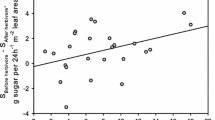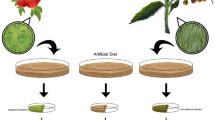Abstract
TobaccoNicotiana tabacum L. is a host plant ofHelicoverpa armigera (Hübner),Helicoverpa assulta Guenée andSpodoptera litura (Fabricius) (Lepidoptera, Noctuidae). The difference in leaf nicotine response to the feeding by these three larvae and the mechanical simulation of their feeding was examined by HPLC. Results indicated that nicotine induction was suppressed byH. armigera andH. assulta larvae feeding or by simulated damage treated with their labial glands extracts. The production of nicotine was also suppressed by the glucose oxidase fromAspergillus niger when it was treated on mechanically wounded leaf area. On the contrary, the nicotine production was stimulated byS. litura larva feeding or by simulated damage treated with its labial gland extract. Heat denature can not counteract the stimulation effect of theS. litura labial gland extracts to tobacco nicotine production. The glucose oxidase activity was detected in labial gland extracts of bothH. armigera andH. assulta, but the activity inH. armigera was significantly higher than that inH. assulta. No glucose oxidase activity was detected in labial gland extracts ofS. litura. It is shown that the glucose oxidase activity in labial glands of caterpillars plays an important role in the nicotine response to herbivory. The glucose oxidase was mainly contained in the labial gland ofH. armigera larva, and had the highest activity at pH 7.0. D-Glucose was the optimal substrate of the glucose oxidase. Labial gland glucose oxidase activities varied daily during larval development with high activities found when larvae were actively feeding.
Similar content being viewed by others
References
Stotz, H. U., Kroymann, J., Mittchell-Olds, T., Plant-insect interactions, Cur. Opin. Plant. Biol., 1999, 2: 268–272.
Ryan, C. A., The systemin signaling pathway: Differential activation of plant defensive genes, BBA-Proteins and Proteomics, 2000, 1477: 112–121.
Green, T. R., Ryan, C. A., Wound induced proteinase inhibitor in plant leaves: A possible defense mechanism against insects, Science, 1972, 175: 776–777.
Blechert, S., Brodschelm, W., Hölder, S. et al., The octadecanoic pathway: Signal molecules for the regulation of secondary pathways, Proc. Natl. Acad. Sci. USA, 1995, 92(10): 4099–4105.
Reymond, P., Weber, H., Damond, M. et al., Differential gene expression in response to mechanical wounding and insect feeding inArabidopsis, Plant Cell, 2000, 12: 707–719.
Korth, K., Dixon, R. A., Evidence for chewing insect-specific molecular events distinct from a general wound response in leaves, Plant Physiol., 1997, 115(4): 1299–1305.
Stout, M. J., Workman, K. V., Bostock, R. M. et al., Specificity of induced resistance in the tomato,Lycopersicon esculentum, Oecologia, 1998, 113(1): 74–81.
Baldwin, I. T., The alkaloidal responses of wild tobacco to real and simulated herbivory, Oecologia, 1988, 77: 378–381.
Schittko, U., Hermsmeier, D., Baldwin, I. T., Molecular interactions between the specialist herbivoreManduca sexta (Lepidoptera, Sphingidae) and its natural hostNicotiana attenuata, Part II: Accumulation of plant mRNAs in response to insect-derived cues, Plant Physiol., 2001, 125(2): 701–710.
Halitschke, R., Schittko, U., Pohnert, G. et al., Molecular interactions between the specialist herbivoreManduca sexta (Lepidoptera, Sphingidae) and its natural hostNicotiana attenuata, Part III: Fatty acid-amino acid conjugates in herbivore oral secretions are necessary and sufficient for herbivore-specific plant responses, Plant Physiol., 2001, 125(2): 711–717.
Hermsmeier, D., Schitko, U., Baldwin, I. T., Molecular interactions between the specialist herbivoreManduca sexta (Lepidoptera, Sphingidae) and its natural hostNicotiana attenuata, Prat I: Large scale changes in the accumulation of growthand defense-related plant mRNAs, Plant Physiol., 2001, 125(2): 683–700.
Mattiacci, L., Dicke, M., Posthumus, M. A., β-Glucosidase: An elicitor of herbivore-induced plant odor that attracts host-searching parasitic wasps, Proc. Natl. Acad. Sci. USA, 1995, 92(6): 2036–2040.
Alborn, H. T., Turlings, T. C. J., Jones, T. H., An elicitor of plant volatiles from beet armyworm oral secretion, Science, 1997, 276(5314): 945–949.
Roda, A. L., Baldwin, I. T., Molecular technology reveals how the induced direct defenses of plants work, Basic Appl. Ecol., 2003, 4(1): 15–26.
McCloud, E. S., Baldwin, I. T., Herbivory and caterpillar regurgitants amplify the wound-induced increases in jasmonic acid but not nicotine inNicotiana sylvestris, Planta, 1997, 203: 430–435.
Eichenseer, H., Mathews, M. C., Bi, J. L. et al., Salivary glucose oxidase: multifunctional roles forHelicoverpa zea? Arch. Insect. Biochem. Physiol., 1999, 42(1): 99–109.
Musser, R. O., Hum-Musser, S. M., Eichensser, H. et al., Caterpillar saliva beats plant defences, Nature, 2002, 416(11): 599–600.
Baldwin, I. T., Inducible nicotine production in nativeNicotiana as an example of adaptive phenotypic plasticity, J. Chem. Ecol., 1999, 25: 3–30.
Baldwin, I. T., Karb, M. J., Ohnmeiss, T. E., Allocation of15N from nitrate to nicotine: production and turnover of a damage-induced mobile defense, Ecology, 1994, 75: 1703–1713.
Kahl, J., Siemens, D. H., Aerts, R. J. et al., Herbivore-induced ethylene suppresses a direct defense but no a putative indirect defense against an adapted herbivore, Planta, 2000, 210: 336–342.
Saunders, J. A., Blume, D. E., Quantification of major tobacco alkaloids by high-performance liquid chromatography, J. Chromatogr., 1981, 205: 147–154.
Bergmeyer, H. U., Gawehn, K., Grassl, M., Methods of Enzymatic Analysis, 2nd ed, Volume I, New York: Academic Press, 1974. 457–458.
Bradford, M. M., A rapid and sensitive method for the quantification of microgram quantities of protein utilizing the principle of protein-dye binding, Anal. Biochem., 1976, 72(7): 248–254.
Schepartz, A. I., Subers, M. H., The glucose oxidase of honeybee I. Purification and some general properties of the enzyme, Biochim. Biophys. Acta, 1964, 85: 228–237.
Kelley, R. L., Reddy, C. A., Glucose oxidase ofPhanerochaete chrysosporium, Methods in Enzymology 161B (eds. Wood, W. A., Kellogg, S. C.), San Diego: Academic Press, 1988, 307–323.
Mizusaki, S., Tanabe, Y., Noguchi, M. et al., Activities of ornithine decarboxylase, putrescine N-methyltransferase and N-methylputrescine oxidase in tobacco roots in relation to nicotine biosynthesis, Plant Cell Physiol., 1973, 14: 103–110.
Saunders, J. W., Bush, L. P., Nicotine biosynthetic enzyme activities inNicotiana tabacum genotypes with different alkaloids levels, Plant Physiol., 1979, 64: 236–240.
Feth, F., Wagner, R., Wagner, K. G., Regulation in tobacco callus of enzyme activities of the nicotine pathway, Part I: The route from ornithine to methylpyrroline, Planta, 1986, 168: 402–407.
Winz, R. A., Baldwin, I. T., Molecular interactions between the specialist herbivoreManduca sexta (Lepidoptera, Sphingidae) and its natural hostNicotiana attenuata, Part III: Insect-induced ethylene reduces jasmonate-induced nicotine accummulation by regulating putrescine N-methyltransferase transcripts, Plant Physiol., 2001, 125(4): 2189–2202.
Voelckel, C., Schittko, U., Baldwin, I. T., Herbivore-induced ethylene burst reduces fitness costs of jasmonate and oral secretioninduced defenses inNicotinana attenuate, Oecologia, 2001, 127: 274–280.
Chamnongpol, S., Willekens, H., Moeder, W. et al., Defense activation and enhanced pathogen tolerance induced by H2O2 in transgenic tobacco, Proc. Natl. Acad. Sci. USA, 1998, 95(10): 5818–5823.
Begliomini, A. L., Montedorom, G. F., Servili, M., Oxidoreductases from tomato fruit inhibitory effect of fungal glucose oxidase, J. Food Biochem., 1995, 19: 161–173.
Lee, Y., Yoon, I., Sun, S. et al., Enhanced disease resistance in transgenic cabbage and tobacco expressing a glucose oxidase gene fromAspergillus niger, Plant Cell Rep., 2002, 20: 857–863.
Author information
Authors and Affiliations
Corresponding author
About this article
Cite this article
Zong, N., Wang, C. Induction of nicotine in tobacco by herbivory and its relation to glucose oxidase activity in the labial gland of three noctuid caterpillars. Chin.Sci.Bull. 49, 1596–1601 (2004). https://doi.org/10.1007/BF03184128
Received:
Accepted:
Issue Date:
DOI: https://doi.org/10.1007/BF03184128




